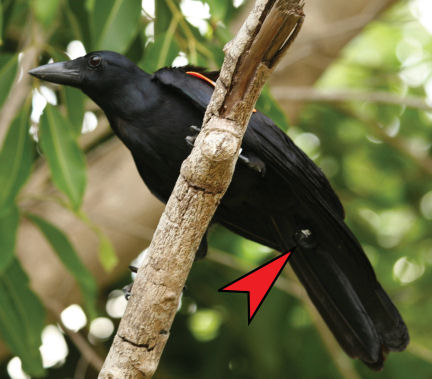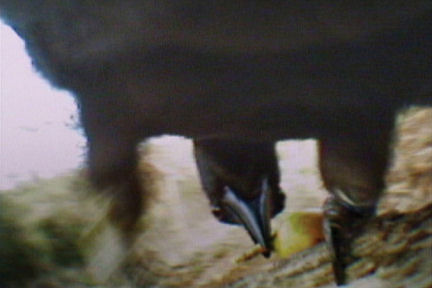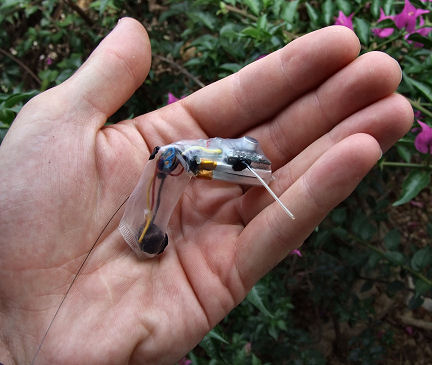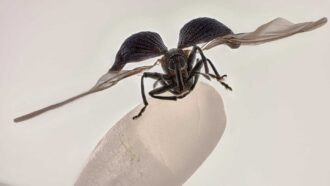Crows Carry Cameras for Science
Tiny cameras attached to the tail feathers of crows allow scientists to observe the birds using tools in the wild.
Share this:
- Share via email (Opens in new window) Email
- Click to share on Facebook (Opens in new window) Facebook
- Click to share on X (Opens in new window) X
- Click to share on Pinterest (Opens in new window) Pinterest
- Click to share on Reddit (Opens in new window) Reddit
- Share to Google Classroom (Opens in new window) Google Classroom
- Click to print (Opens in new window) Print
By Emily Sohn
Small video cameras have started to show up everywhere—on the helmets of skiers, in the cages of zoo animals, and in medical tools that enter the human body, among other places.
Now, British biologists have found a new location for mini-video cameras: on the tail feathers of tropical crows. The cameras look through the legs of the birds, transmitting what they record to a person holding a receiver several hundred meters away.
 |
|
The arrow in the picture above points to a tiny camera attached to the tail feathers of a New Caledonian crow. Crowcams captured images of the birds using sticks as tools to probe for food (image below).
|
| J. Troscianko |
 |
|
|
| © Behavioural Ecology Research Group |
The animals don’t seem to mind the cameras; they carry on like normal. By watching the video, scientists are discovering new things about what birds do when people aren’t around.
“We are the first ones to do this on wild birds,” says Christian Rutz of the University of Oxford in England.
Attaching cameras to animals is not a new idea. In 1986, Greg Marshall, now the in-house specialist for remote imaging at the National Geographic Society in Washington, D.C., found a way to stick a camera onto back of a loggerhead turtle in captivity.
Since then, people have put cameras on more than 60 species of animals. About half of those have been for research purposes. Others have been done to test equipment or make films.
Using cameras to track animals without people around can be revealing, says physiological ecologist Martin Wikelski of Princeton University.
“As soon as you monitor [animals] remotely, you find them doing things you never knew they were doing before,” Wikelski says. “I think this approach has an amazing future.”
Size is one of the biggest challenges to this type of “crittercam” technology. Researchers try not to burden an animal with equipment that weighs more than 5 percent of the creature’s weight. Until recently, there haven’t been devices small enough to equip relatively small creatures.
Cell phone makers, however, have been pushing the limits of little cameras. With the new technology, Rutz’s team assembled a video system that weighed just 13 grams (less than half an ounce). That’s about as heavy as three nickels.
Rutz wanted to use the system to study New Caledonian crows (Corvus moneduloides) for several reasons—such as their tool use. The birds, which live in the South Pacific, use twigs and leaves to make hooks and probes with sawlike edges. They use these tools to pry insects from hard-to-reach places (see “Tool Use Comes Naturally to Crows”).
To understand more about how and why the crows use tools, researchers need a lot of details about their lives in the wild, Rutz says. However, the birds live in rugged forests, making it hard for researchers to follow and observe them. Video cameras seemed like the perfect solution to Rutz.
The scientists attached small video cameras (shown below) to 12 New Caledonian crows. The cameras recorded up to 38 minutes of video from each bird—at which point their batteries died.
(The birds regularly drop their tail feathers and grow new ones. So, after the experiments, the researchers were able to recover the devices, and the birds didn’t have to carry around dead cameras forever).
Videos included footage of the crows using plant stems as tools to probe for food and even carrying a tool from one place to another. The images showed that birds on the ground pick up just 8 bits of food an hour. That’s not a lot of food, and Rutz speculates that these birds have developed their tool-making skills to help make up for such skimpy lunches.
Future mini-camera footage should reveal even more about the secret lives of crows and other creatures.—Emily Sohn
 |
|
|
| © Behavioural Ecology Research Group |
Going Deeper:
Milius, Susan. 2007. Crowcam: Camera on bird’s tail captures bird ingenuity. Science News 172(Oct. 6):214. Available at http://www.sciencenews.org/articles/20071006/fob8.asp .
To see several video clips taken by the “crowcam,” click here. (17 MB .MOV file. Broadband connection strongly reccomended.)
For movies of tool use by crows, go to users.ox.ac.uk/~kgroup/tools/development.shtml (University of Oxford).
For more on New Caledonian crows, go to en.wikipedia.org/wiki/New_Caledonian_Crow (Wikipedia).
Sohn, Emily. 2005. Tool use comes naturally to crows. Science News for Kids (Jan. 19). Available at http://www.sciencenewsforkids.org/articles/20050119/Note3.asp .
______. 2003. Better tools for techno crows. Science News for Kids (March 26). Available at http://www.sciencenewsforkids.org/articles/20030326/Note3.asp .







